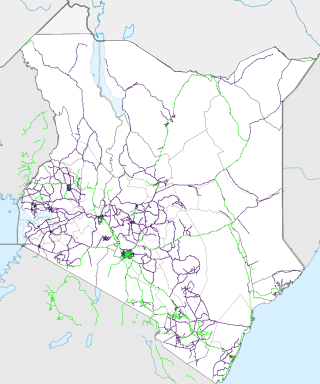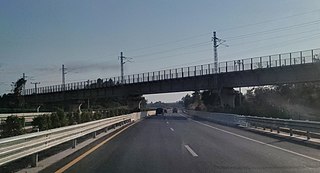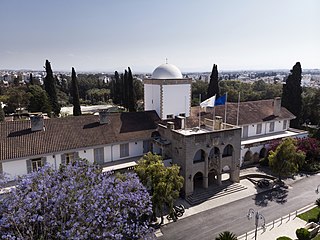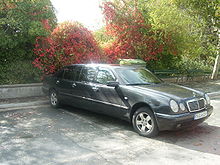
Transport in the Dominican Republic utilizes a system of roads, airports, ports, harbours, and an urban railway.
Transportation in Ecuador is the transport infrastructure networks in Ecuador and those connecting the country with other countries. Transportation in Ecuador include aviation, highways, pipelines, ports and harbors, railways and waterways. Apart from transporting passengers, the country is a relatively small exporter of fruits and vegetables such as banana, papayas and pineapples.

Transport in Greece has undergone significant changes in the past two decades, vastly modernizing the country's infrastructure and transportation. Although ferry transport between islands remains the prominent method of transport between the nation's islands, improvements to the road infrastructure, rail, urban transport, and airports have all led to a vast improvement in transportation. These upgrades have played a key role in supporting Greece's economy, which in the past decade has come to rely heavily on the construction industry.

Transport in Kenya refers to the transportation structure in Kenya. The country has an extensive network of paved and unpaved roads.

This article concerns the systems of transportation in Laos. Laos is a country in Asia, which possesses a number of modern transportation systems, including several highways and a number of airports. As a landlocked country, Laos possesses no ports or harbours on the sea, and the difficulty of navigation on the Mekong means that this is also not a significant transport route.

Transportation in Malaysia started to develop during British colonial rule, and the country's transport network is now diverse and developed. Malaysia's road network is extensive, covering 290,099.38 kilometres, including 2,016.05 km of expressways. The main highway of the country extends over 800 km, reaching the Thai border from Singapore. Peninsular Malaysia has an extensive road network, whilst the road system in East Malaysia is not as well-developed. The main modes of transport in Peninsular Malaysia include buses, trains, cars and to an extent, commercial travel on airplanes.

Railways: 0 km

The government of Myanmar has two ministries controlling transportation, the Ministry of Transport and the Ministry of Rail Transport.

There are a number of systems of transport in Sierra Leone, a country in West Africa, which possess road, rail, air and water infrastructure, including a network of highways and several airports.

Switzerland has a dense network of roads and railways. The Swiss public transport network has a total length of 24,500 kilometres and has more than 2600 stations and stops.

Transport in Ukraine includes ground transportation, water, air transportation, and pipelines. The transportation sector accounts for roughly 11% of the country's gross domestic product and 7% of total employment.

Nicosia, also known as Lefkosia in Greek, its Turkish name Lefkoşa, is the capital and largest city of Cyprus.

Limassol is a city on the southern coast of Cyprus and capital of the Limassol district. Limassol is the second largest urban area in Cyprus after Nicosia, with an urban population of 195,139 and a district population of 262,238. The Limassol municipality is the most populated in Cyprus, with a population of 108,105, followed by Strovolos municipality in Nicosia.
This article talks about transportation in the Bahamas, a North American archipelagic state in the Atlantic Ocean.

Paphos is a coastal city in southwest Cyprus and the capital of Paphos District. In classical antiquity, two locations were called Paphos: Old Paphos, today known as Kouklia, and New Paphos. It is the fourth-largest city in the country, after Nicosia, Limassol and Larnaca, with an urban population of 63,600 in 2018.

Paphos International Airport is a joint civil-military public airport located 6.5 kilometres south-east of the city of Paphos on the Mediterranean island of Cyprus. It is the country's second largest airport, after Larnaca International Airport. Paphos Airport is commonly used by tourists on vacation in western Cyprus, providing access to popular resorts such as Coral Bay, Limassol, and Paphos itself.

The Presidential Palace is the official residence and principal workplace of the President of the Republic of Cyprus. It is located close to the centre of Nicosia, the capital city of Cyprus, and is surrounded by a thick pine woodland.

The Cyprus Police, is the national police service of the Republic of Cyprus, falling under the Ministry of Justice and Public Order since 1993.

Since the arrival of the first motor cars on the island in 1907, Cyprus has developed a modern road network. According to 2002 statistics, the road network in the Republic of Cyprus-administered areas of Cyprus consists of about 7,206 km of paved and 4,387 km of unpaved roads. Although the first motorway in Cyprus, A1, was completed as recently as October 1985, the country already has the most motorway km per capita among all European Union members. There are no toll paying roads in Cyprus to date.
The Cyprus Ports Authority is a semi-autonomous government agency that is responsible for the supervision and oversight of the ports and port facilities of Cyprus. Established by the Cyprus Ports Authority Law of 1973, it is based in Nicosia.























